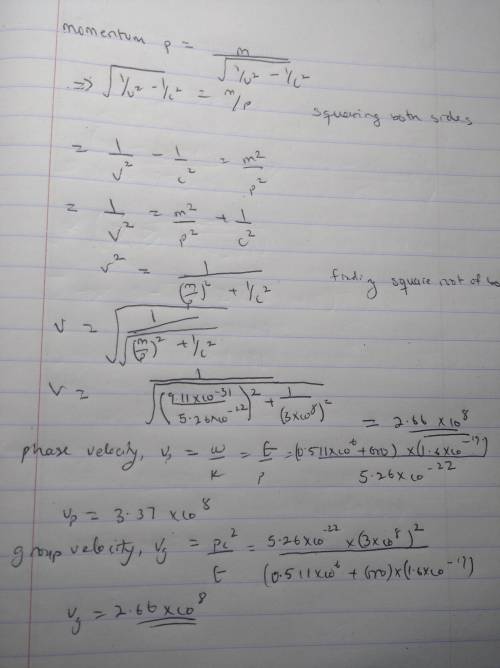
Physics, 22.10.2020 19:01 montgomerykarloxc24x
Consider electrons of kinetic energy 6.0 eV and 600 keV. For each electron, find the de Broglie wavelength, particle speed, phase velocity (speed), and group velocity (speed). Comment on the relationship between particle velocity, phase velocity and group velocity.

Answers: 3
Another question on Physics

Physics, 21.06.2019 22:40
In physics the desire of an object to keep doing what it is doing is termed?
Answers: 1

Physics, 22.06.2019 07:30
Some material consisting of a collection of microscopic objects is kept at a high temperature. a photon detector capable of detecting photon energies from infrared through ultraviolet observes photons emitted with energies of 0.3 ev, 0.5 ev, 0.8 ev, 2.0ev, 2.5ev, and 2.8ev. these are the only photon energies observed. (a) draw and label a possible energy-level diagram for one of the microscopic objects, which has four bound states. on the diagram, indicate the transitions corresponding to the emitted photons. explain briefly. (b) would a spring–mass model be a good model for these microscopic objects? why or why not? (c) the material is now cooled down to a very low temperature, and the photon detector stops detecting photon emissions. next, a beam of light with a continuous range of energies from infrared through ultraviolet shines on the material, and the photon detector observes the beam of light after it passes through the material. what photon energies in this beam of light are observed to be significantly reduced in intensity (“dark absorption lines”)? explain briefly.
Answers: 3

Physics, 22.06.2019 17:30
Students in an introductory physics lab are performing an experiment with a parallel-plate capacitor made of two circular aluminum plates, each 11 cm in diameter, separated by 1.0 cm. how much charge can be added to each of the plates before a spark jumps between the two plates? for such flat electrodes, assume that value of 3×106n/c of the field causes a spark.
Answers: 2

Physics, 22.06.2019 18:00
The protons in a nucleus are approximately 2 ✕ 10^−15 m apart. consider the case where the protons are a distance d = 1.93 ✕ 10^−15 m apart. calculate the magnitude of the electric force (in n) between two protons at this distance.
Answers: 1
You know the right answer?
Consider electrons of kinetic energy 6.0 eV and 600 keV. For each electron, find the de Broglie wave...
Questions

Mathematics, 28.03.2021 06:00



English, 28.03.2021 06:00

Engineering, 28.03.2021 06:00


Mathematics, 28.03.2021 06:10


Physics, 28.03.2021 06:10

Mathematics, 28.03.2021 06:10

English, 28.03.2021 06:10

Mathematics, 28.03.2021 06:10

Social Studies, 28.03.2021 06:10


Mathematics, 28.03.2021 06:10




Mathematics, 28.03.2021 06:10





